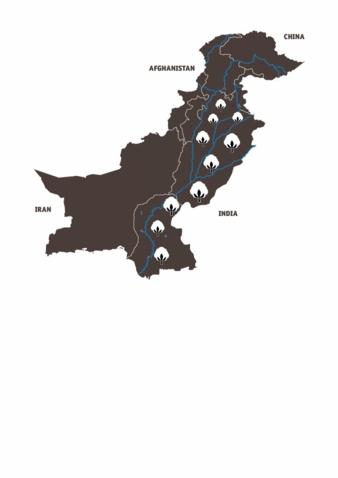12/10/2017 – Pakistan — auf Deutsch lesen
Wholesaleprices for Seed Cotton up 24 Percent
Pakistan’s 2017/18 cotton production is forecast at 9.0 million 480 lb bales, down slightly from the current USDA estimate due to a slight reduction in area, but in keeping with the general expectation that yields and area have improved from the lows of 2015 (yield) and 2016 (area).

Pakistan’s 2017/18 cotton production is forecast at 9.0 million 480 lb bales, down slightly from the current USDA estimate due to a slight reduction in area, but in keeping with the general expectation that yields and area have improved from the lows of 2015 (yield) and 2016 (area) © Bremer Baumwollbörse/d-maps.com
While monsoon rains during July till mid-August were below average, Pakistan’s cotton crop is largely dependent on irrigation and water supplies have reportedly been adequate.
Insect infestations of the white fly have occurred, but have not exceeded expectations. The weak expression of resistance to pink bollworm, a result of extensive back crossing, in Pakistan’s biotech cotton could result in increased infestation depending on weather conditions during September. But higher cotton prices should prompt farmers to manage their crops and pursue additional pickings.
A key question heading into any harvest in Pakistan is the number of hand pickings that farmers will plan especially those who need to make way for the planting of the winter (Rabi) wheat crop. Wholesale prices of seed cotton for 2016/17 are up 24 percent increase from a year ago suggesting that farmers will pursue at least an average number of pickings; still, farmers typically try to complete wheat planting by November 15 to avoid yield reductions from late sowing.
The estimate of 2016/17 imports is slightly lower at 2.2 million 480 lb bales based on preliminary official data. The Government of Pakistan has reinstated the tariff and sales tax on imported cotton (previously and temporarily zero), raising the cost of imported cotton by about nine percent. The move is timed with the onset of harvest and should help facilitate a seasonal reduction in import volumes while harvest is underway.
Source USDA/FAS Gain Report Sep.2017
Extract from Bremen Cotton Report 37/38 2017 reprinted by kind permission of the Bremen Cotton Exchange. More information www.baumwollboerse.de/en/



